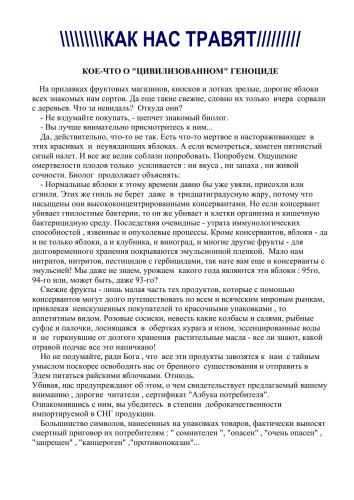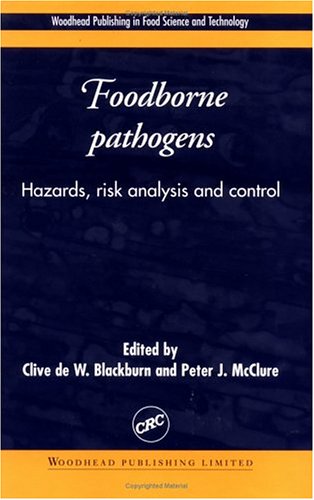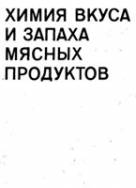D Watson1855737345, 9781855737341, 9781855739109, 0849325587, 1855739100
Pesticides, Veterinary and other Residues in Food reviews the wealth of research on assessing and managing the risks from pesticide, veterinary, and other chemical residues in food. Beginning with an introductory chapter on the key issues in food toxicology, Part 1 covers the assessment and management of risks. Chapters cover genetic susceptibility, dietary carcinogens, good agricultural practice and HACCP systems, and targeted and rapid methods for analyzing residues in food. Part 2 looks at veterinary residues, covering their safety, toxicology, and detection. Part 3 examines pesticides. In the final part, chapters summarize a wide range of other chemical residues in food.
David Watson is a Fellow of the prestigious Royal Society of Chemistry and the Institute of Biology, and his expertise and insight has made Pesticides, Veterinary and Other Residues in Food a standard reference for all those concerned with ensuring the safety of food.
Table of contents :
Contents……Page 5
Contributor contact details……Page 13
1.1 Introduction: defining food toxicology……Page 19
1.2 Types of toxicant: contaminants……Page 20
1.3 Types of toxicant: naturally-occurring toxicants……Page 25
1.4 Types of toxicant: food processing toxicants……Page 28
1.5 Current issues: pathogens, genetic variability and antibiotic resistance……Page 31
1.6 Current issues: novel foods and natural toxicants……Page 38
1.7 Conclusions……Page 41
1.8 References……Page 42
2.1 Introduction: diet and cancer……Page 47
2.2 Dietary carcinogens and anticarcinogens: mycotoxins, heterocyclic amines, aromatic hydrocarbon s, N-nitroso compounds……Page 48
2.3 Genetic influences on carcinogen-metabolizing enzymes……Page 53
2.4 Evidence of gene-diet interactions……Page 55
2.5 Summary and future trends……Page 58
2.7 References……Page 60
3.1 Introduction: mutagenicity test programmes……Page 68
3.3 Selecting appropriate tests……Page 70
3.4 Assessing dose-response relationships……Page 77
3.5 Developing test methodologies……Page 79
3.6 Conclusions……Page 80
3.8 References and further reading……Page 81
4.1 Introduction: risks posed by organohalogen compounds……Page 84
4.2 Organohalogens as neurotoxins……Page 85
4.3 Neurobehavioural consequences of PCB exposure……Page 87
4.4 Molecular mechanisms of organohalogen-induced toxicity……Page 94
4.5 Conclusion……Page 97
4.7 References……Page 98
5.1 Introduction……Page 106
5.2 The principles of the immunoassays……Page 107
5.3 The use of immuno-affinity chromatography……Page 110
5.4 Developing immunoassays to detect residues in food and water……Page 116
5.5 Recent developments in immunoassays……Page 122
5.6 Recent developments in immuno-affinity chromatography……Page 124
5.7 The use of immunoassays in residue analysis……Page 127
5.8 References……Page 132
6.1 Introduction……Page 137
6.2 Safety issues in the food chain supply……Page 138
6.3 Good agricultural practice……Page 144
6.4 The Hazard Analysis Critical Control Point (HACCP) system……Page 149
6.5 The HACCP study……Page 152
6.6 Implementing and maintaining HACCP systems……Page 167
6.7 Future trends……Page 168
6.10 Sources of further information and advice……Page 170
6.11 References and bibliography……Page 171
7.1 Introduction……Page 175
7.2 Types of toxicity study……Page 176
7.3 Elaboration of maximum residue limits (MRLs) for veterinary drugs in the EU……Page 179
7.4 Elaboration of MRLs for particular foods in the EU……Page 184
7.5 International regulation: the role of the Joint Expert Committee on Food Additives (JECFA)……Page 186
7.6 Conclusions……Page 187
7.7 References……Page 189
8.2 Griseofulvin……Page 193
8.3 Beta-Lactam antibiotics: penicillins and cephalosporins……Page 195
8.4 Macrolide antibiotics: spiramycin, tylosin and tilmicosin……Page 199
8.5 Aminoglycosides……Page 201
8.6 Fluoroquinolones……Page 203
8.8 Carbadox and olaquindox……Page 204
8.9 Furazolidone and related compounds……Page 206
8.10 Chloramphenicol……Page 207
8.11 Ivermectin and related compounds……Page 209
8.12 Tranquillisers: xylazine and azaperone……Page 211
8.13 Carazolol……Page 212
8.15 References……Page 213
9.1 Introduction……Page 242
9.2 Veterimary medicinal products……Page 243
9.3 Methods for detecting residues……Page 244
9.4 Validating detection methods……Page 247
9.5 Rapid on-line confirmation of different veterinary residues……Page 249
9.6 Future trends……Page 263
9.8 References……Page 264
10.1 Introduction: detecting the use of growth promoters……Page 267
10.2 Existing detection techniques and their limitations……Page 268
10.3 The use of immunoassays to detect growth promoters……Page 270
10.4 Key issues in developing new biosensors……Page 276
10.5 References……Page 277
11.1 Introduction……Page 280
11.2 The use of anticoccidial drugs in poultry farming……Page 281
11.3 The use of time-resolved fluoroimmunoassays (TR-FIAs)……Page 283
11.4 Screening for coccidiostat residues by automated TR-FIAs……Page 285
11.6 Acknowledgement……Page 289
11.7 References……Page 290
12.1 Introduction……Page 295
12.2 Pesticide regulation in the United States……Page 296
12.3 Sample collection, preparation, and analysis……Page 299
12.4 Results from pesticide surveillance programs……Page 301
12.5 Interpreting the results of pesticide residue surveillance programs……Page 308
12.6 Future trends……Page 309
12.8 References……Page 310
13.1 Introduction……Page 312
13.2 Detecting pedticides: physicochemical methods……Page 315
13.3 Detecting pesticides: biological methods……Page 316
13.4 The principles of biosensors……Page 319
13.5 Developing low-cost biosensors……Page 326
13.6 Using biosensors: pesticide residues in grain, fruit and vegetables……Page 327
13.7 Future trends……Page 329
13.9 Further reading……Page 330
14.1 Introduction: key issues in detection……Page 332
14.2 Sample preparation……Page 333
14.3 Techniques for rapid screening of samples……Page 347
14.4 Separation techniques……Page 351
14.5 Detectors used in combination with separation techniques……Page 360
14.6 Future trends……Page 371
14.7 Sources of further information and advice……Page 372
14.8 References……Page 373
15.1 Introduction……Page 378
15.2 Conventional techniques and immunoassays for detecting fungicide residues……Page 386
15.3 Detecting fungicide residues using biosensors……Page 391
15.5 Sources of further information and advice……Page 398
15.7 References……Page 399
16.2 Trends in sample preparation……Page 404
16.3 Analytical methods for particular herbicide residues……Page 413
16.5 Sources of further information and advice……Page 421
16.6 References……Page 423
17.1 Introduction……Page 431
17.2 Mechanism of action of xenoestrogens……Page 433
17.3 Assays for xenoestrogens……Page 437
17.4 Measuring risks from different xenoestrogens……Page 439
17.5 Health effects of xenoestrogens……Page 441
17.6 Xenoestrogens in food and levels of dietary intake……Page 444
17.7 Regulatory control of xenoestrogens……Page 448
17.8 Future trends……Page 449
17.11 References……Page 450
18.1 Introduction: defining dietary estrogens……Page 454
18.2 The range of dietary estrogens……Page 455
18.3 Assessing the estrogenicity of dietary estrogens……Page 458
18.4 Assessing the toxicity of dietary estrogens……Page 464
18.5 The benefits of dietary estrogens: cancer prevention……Page 470
18.6 The benefits of dietary estrogens: preventing osteoporosis and atherosclerosis……Page 475
18.7 Dietary intakes of estrogens……Page 480
18.8 Future trends and sources of further information and advice……Page 481
18.9 References……Page 482
19.1 Introduction……Page 491
19.2 Physical and chemical properties of PAHs……Page 492
19.3 Health effects of PAHs……Page 497
19.4 Analytical methods for PAHs……Page 507
19.5 The occurrence of PAHs in foods……Page 512
19.6 Future trends……Page 522
19.7 Sources of further information and advice……Page 523
19.9 References……Page 524
20.2 Dioxins and PCBs……Page 537
20.3 Assessing the toxic effects of dioxins and dioxin-like PCBs……Page 541
20.4 Analytical methods and current exposure levels……Page 543
20.5 Brominated flame retardants……Page 546
20.7 References……Page 549
21.1 Introduction: the problem of organic contaminants……Page 554
21.2 Sources of organic contaminants……Page 555
21.3 Organic contaminants in fish……Page 556
21.4 Analysing particular organic contaminants in fish……Page 577
21.5 Health issues for organic contaminants in fish……Page 583
21.6 Future trends……Page 584
21.8 References……Page 585
22.1 Introduction: the nature of allergens and allergies……Page 595
22.2 Types of plant food allergens and their characteristics……Page 596
22.3 Identifying potentially allergenic proteins: bioinformatics……Page 603
22.4 Identifying potentially allergenic proteins: resistance to pepinolysis and IgE reactivity……Page 605
22.7 References……Page 610
23.2 Regulatory background……Page 616
23.3 Requirements for toxicological testing……Page 618
23.4 Cytotoxicity tests……Page 619
23.5 Genotoxicity tests……Page 621
23.6 Applying tests to paper and board……Page 623
23.7 Conclusions and future trends……Page 625
23.8 References……Page 626
24.2 Methods of preparing food samples for analysis……Page 628
24.3 Analytical methods for metal detection……Page 632
24.5 Lead speciation in food……Page 636
24.6 Mercury speciation in food……Page 637
24.7 Arsenic speciation in food……Page 640
24.8 Future trends……Page 644
24.9 References……Page 645
25.1 Introduction……Page 659
25.2 Types of mycotoxins found in food and animal feed……Page 660
25.3 Risk management and control of mycotoxins in food……Page 665
25.4 Sampling for mycotoxins……Page 669
25.5 Standardization of methods for detecting mycotoxins……Page 671
25.6 The range of analytical nmethods for mycotoxins……Page 673
25.8 References……Page 679
Index……Page 688







Reviews
There are no reviews yet.